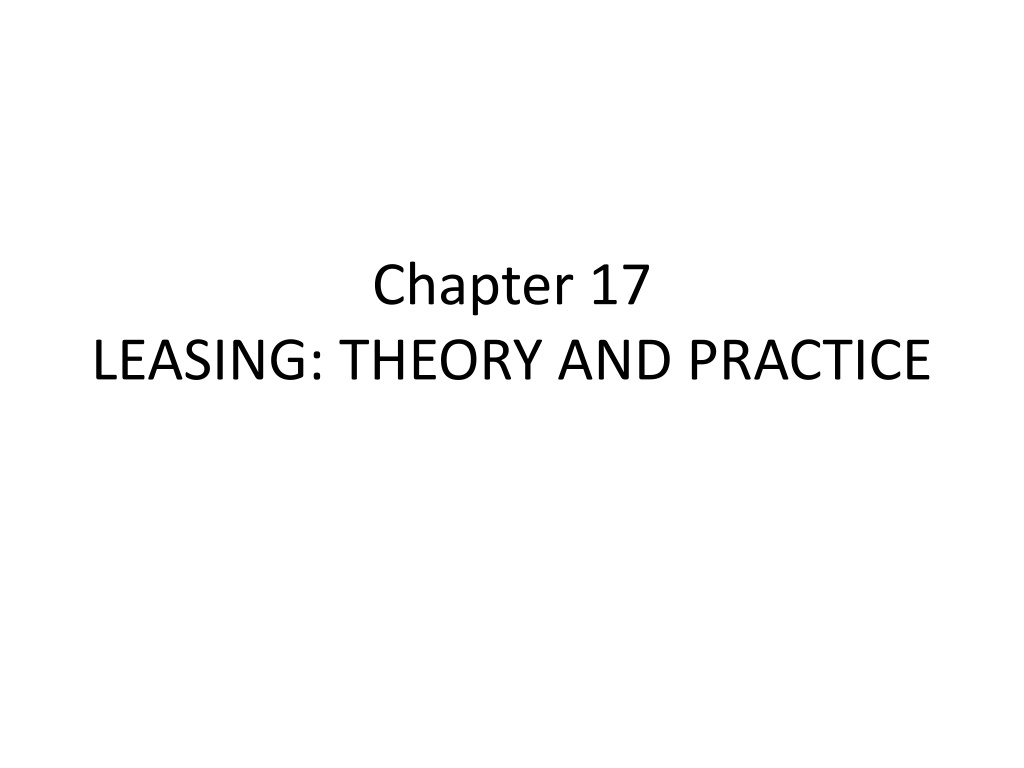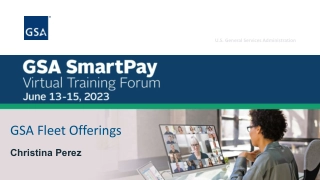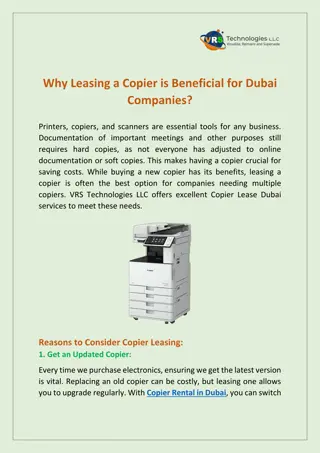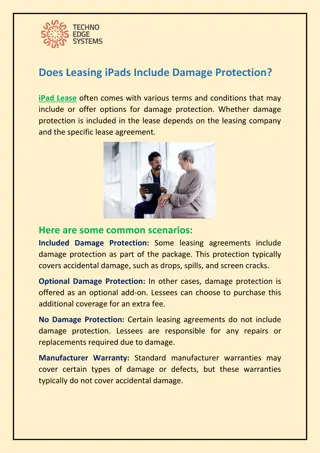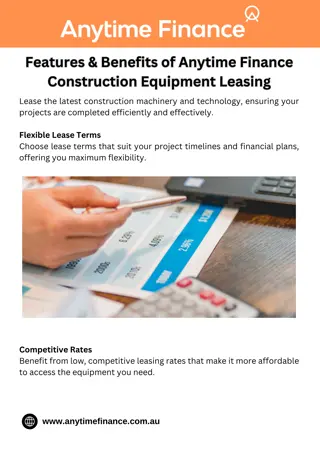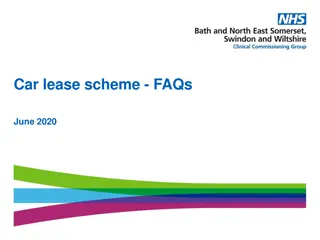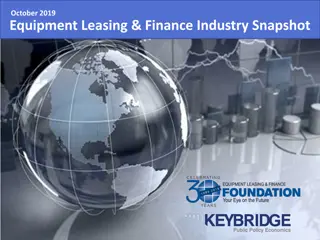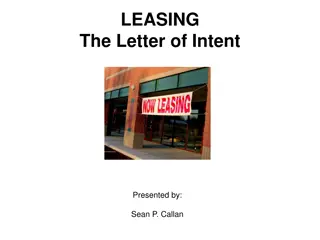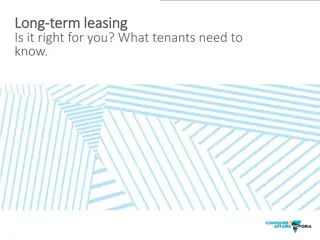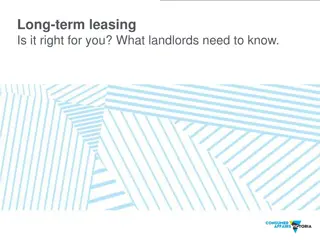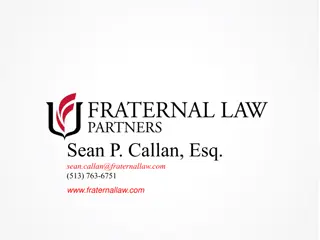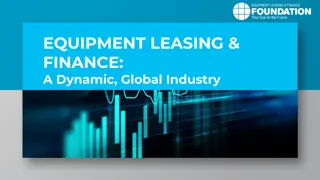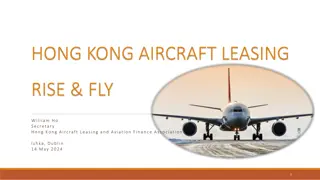LEASING: THEORY AND PRACTICE
Chapter 17 delves into the decision-making process between buying and leasing capital assets and equipment. It covers various financial theories, accounting for leases, cash flow estimations, valuation of riskless and risky cash flows, CAPM implications, and options to evaluate salvage values in financial leases.
Download Presentation

Please find below an Image/Link to download the presentation.
The content on the website is provided AS IS for your information and personal use only. It may not be sold, licensed, or shared on other websites without obtaining consent from the author. Download presentation by click this link. If you encounter any issues during the download, it is possible that the publisher has removed the file from their server.
E N D
Presentation Transcript
Chapter 17 LEASING: THEORY AND PRACTICE
17.1 INTRODUCTION 17.2 REASONS AND TYPES OF LEASING ARRANGEMENTS 17.3 ACCOUNTING FOR LEASES 17.4 CASH FLOW ESTIMATION AND PRESENT VALUE ANALYSIS OF LEASE OR BUY ALTERNATIVES 17.5 VALUATION OF RISKLESS AND RISKY CASH FLOWS FOR THE LEASE OR BUY DECISION 17.6 CAPM AND THE LEASE OF BUY DECISION 17.7 OPTIONS TO EVALUATE SALVAGE VALUES IN FINANCIAL LEASES 17.8 SUMMARY
17.1 INTRODUCTION Chapter 17 explores the leasing decision. Accounting, marketing, and economic information and finance theory are used to show how managers make the decision to either buy or lease capital assets and equipment. The financial theories discussed in this chapter include the traditional, M & M, CAPM, and OPM theories, which are utilized and demonstrated as an aid to the manager for long-term and short-term evaluation of the lease versus buy decision. The chapter begins with the basic definitions and types of lease arrangements. This is followed by discussions of accounting for leases, cash flow estimations and value determinants of leases, and the value of riskless and risky cash flows for lease versus buy decisions. The next section discusses the CAPM and lease versus buy decisions. Finally, we explain how options are used to evaluate salvage value in financial leases. Appendix 17A derives the discount rate for riskless cash flows.
17.2 REASONS AND TYPES OF LEASING ARRANGEMENTS It is well-known that companies obtain the use of long-term operating assets through a lease rather than a purchase. In a lease, a company acquires the use of an asset such as a copy machine, office space, or even an airplane by financing it directly through the asset s owner. In the airline industry, about one- third of airplanes are leased. Airlines decide to lease versus buy assets for a variety of reasons, including the ability to obtain financing, reduced risk of obsolescence, or operating flexibility. For example, small, recently established airlines, which may have difficulty obtaining capital to buy large airplanes, lease planes to exploit new routes. At the end of fiscal 2016, the operating fleet of Spirit Airlines consisted of 95 airplanes of which 38% were owned and 62% were leased. Spirit also leases most of its land and buildings that it occupies, such as its aircraft maintenance base as well as various computers, cargo, flight kitchens, and training facilities. Is there a difference in the economic substance of acquiring a long-term operating asset (such as an airplane) by issuing long-term debt or acquiring the use of an asset by signing a lease contract? In most cases, there is no real substantial difference in leasing and purchasing. The form of the contract is different, but the substance of these transactions is the same.
The main reasons for leasing an asset instead of purchasing are: a) True lease financing might be cheaper than borrowing or purchasing the asset. This kind of advantage is primarily due to different marginal tax rates faced by the lessor and lessee. Since leasing generally does not require the firm to make a down payment (as most lending institutions do), the effect is to conserve working-capital. Although generally smaller than arrangements, lease payments are prepaid and in that sense are like a down payment. Leasing may preserve the credit and debt capacity of the firm. This, as we shall see, is a result of the accounting conventions in use today. Leasing can reduce the risk of obsolescence and capital-equipment disposal problems. Almost always the term of the lease is less than the life of the asset, particularly so in the case of leases that are cancelable at certain times at the option of the lessee. Leasing is more flexible and convenient than buying an asset. Most lessors deal with leasing arrangements on a regular basis and are used to tailoring these arrangements, within reason, to their client's best interest. b) those required in most purchase c) d) e)
There are many forms of leasing arrangements. The three most common are (1) direct leasing, (2) sale and leaseback, and (3) leveraged leasing. Each leasing type can be further broken down into accounting requirements applicable to the lessor and the lessee. The types of accounting practice required may also determine the type of lease a lessee is willing to undertake. That is, the type of lease undertaken will have different impacts on the lessee s financial statements.
17.2.1 Direct Leasing A direct lease gives the lessee the use of an asset while the lessor retains title and ownership of the asset. In return, the lessor receives contracted lease payments from the lessee as remuneration for the use of the asset. Frequently, direct leases contain provisions requiring the lessor to provide maintenance service; such an arrangement is called a service lase. The lessor may also assist in partial financing of the lessee if necessary. Another distinguishing feature of a direct lease is the cancellation clause, which allows the lessee to cancel the lease at period intervals. The types of lessors are as varied as the number of lessees. Manufacturers of expensive products, such as computers and copy machines, often lease their products to firms or individuals. Trucking firms will purchase fleets of trucks in order to lease them out individually or otherwise. Some firms make a business out of leasing by purchasing and leasing items on a short-term basis. For example, financial intermediaries often purchase capital goods with the intention of leasing them out. This may not be an integral part of their business but does afford tax advantages. (The tax advantages of leasing are discussed in a later section.)
17.2.2 Sale and Leaseback In a sale and leaseback arrangement, a firm sells an asset (most often an asset it just purchased) to a second party and the two parties then enter into a lease in which the original owner leases back the asset from the new owner. The new owner retains title to the asset and all other benefits of ownership, such as tax credits and depreciation allowance. The lessee receives the funds from the sale of the asset along with the use of the asset. In most cases, the asset is sold by the original owner at its fair market value, which includes consideration of trade and volume discounts as well as the current market condition. The main advantage of the sale and leaseback is its accounting treatment, which is discussed later in this chapter.
17.2.3 Leverage Leasing Leverage leasing involves financial leverage, which is not used in the other two forms of leasing. A third party, the lender, supplies a large portion of the funds a lessor needs to purchase an asset it intends to lease out. This type of lease is often used in situations where large capital outlays are necessary for the purchase of the asset. For the lessee, there are no fundamental differences between a leveraged lease and the other two forms of leases. And differences to the lessee are the result of different lease payments required by the lessor due to the degree of leverage used. The lessor, however, is in a different position. As a debtor, the lessor is required to make interest payments. The size of these payments depends on the degree of leverage employed, which, in turn, affects the size and timing of net cash flows to the lessor. Again, the accounting treatment determines whether this type of lease arrangement is advantageous to either party of the agreement. We now discuss these accounting arrangements.
17.3 ACCOUNTING FOR LEASES In the previous section, we mentioned that each form of leasing can be further distinguished by the accounting reporting methods applicable to the lessor and the lessee. In this section, we see how such distinctions are made and the effects they have on each party s financial statements. We also discuss the taxes involved in each leasing practice, which is often a decisive factor in the leasing decision. The 1976 Financial Accounting Standard Board (FASB) Statement No. 13 standardized the procedures for lease accounting. Before this statement was issued, lease obligations of the lessee either were not presented in the firm s financial statements or were given only cursory treatment in a footnote. Hence, leases that resembled debt-financed purchases were easily hidden and kept off the balance sheet. FASB 13 required that capital leases (discussed later in this section) be shown on the lessee s financial statements as if the asset were owned by the firm. The reason for this is that if the lessee contracts for an asset in such a way as to acquire all the risks and benefits associated with the asset, then this asset should be appropriately reflected in the lessee s financial statements.
The following rules are used in the classification of capital and operating leases for lessees. However, according to Fabozzi (1981), even within these guidelines there is a great deal of latitude with respect to classification. From the lessee s standpoint, the lease is a capital lease if it satisfies any of the following four criteria: 1. The lease transfers ownership of the asset to the lessee prior to the expiration of the lease obligation term, including any time covered by bargain renewal options. 2. The lease contains a bargain purchase option that allows the lessee to purchase the leased asset at a price sufficiently lower than the current expected fair market value at the time the option is exercisable. 3. The lease is equal to or greater than 75 percent of the remaining estimated economic life of the leased asset, unless 75 percent of the asset s expected life has already elapsed. 4. The present value of the minimum lease payments including any guarantee by the lessee relating to the lessor s debt and other expenses, equals or exceeds 90 percent of the fair value of the leased asset. Leases that do not meet any of the four criteria listed above are classified as operating leases.
17.3.1 Capital Lease Treatment For a capital lease (a lease that is viewed as a defacto acquisition), the accounting treatment for the lessee is the same as if the asset were actually purchased by the lessee and financed by debt. Equal entries are made in the assets and liabilities of the balance sheet. This reflects the acquisition or use of the asset by the firm as well as the contractual promise to make the scheduled lease payments. The only difficulty with this procedure is determining the value of the asset. FASB 13 requires two estimates of the asset s value, as discussed below. Discount Rate Estimate The discount rate estimate discounts the minimum lease payments plus any expected profits derived from the bargain purchase options included in the lease agreement and deducts any executory costs (insurance, maintenance, and taxes) that may be incurred by the lessor that are embodied in the lease payments. The discount rate that is used is the lessee s marginal borrowing rate (KB) or the interest rate implicit in the lease. The marginal borrowing rate is the rate at the inception of the lease that the lessee would have paid to borrow the funds necessary to buy the leased asset on a secured loan with repayment terms similar to the payment schedule of the lease.
The implicit rate is the internal rate of return that sets the net outlay for the asset (by the lessor) equal to the present value of the lease payments plus any net residual value expected to be realized by the lessor on termination of the lease. The residual value is the estimated fair market value of the leased property at the end of the term of the lease. The lessor often transfers the risk of loss to the lessee through a guarantee of the estimated residual value. The amount of a guaranteed residual value is the price the lessee must pay the lessor for purchase of the leased asset at the termination of the lease. We can illustrate how the implicit interest rate is determined with an example. The city of Tiny Rock has just leased a fleet of ten buses for its new transportation system. The lease contract is to run for ten years. The fleet was recently purchased by the Metropolitan Bank; hence, the bank is the lessor. Annual lease payments prepaid each year are $85,000, and at the end of the lease term Tiny Rock has the option to buy the fleet for $20,000, at which time the market value of the buses is also expected to be $20,000. Tiny Rock estimates that the buses cost the bank $544,337. The implicit interest rate in the lease is the value r in the following equation:
That is, Solving for r yields 12 percent as the implicit interest rate on the lease. The implicit rate on the lease may be higher, lower, or equal to the lessee s marginal borrowing rate. If the implicit rate is lower than the marginal borrowing rate, then the implicit rate must be used; otherwise, the lessor has a choice of using either the implicit rate or the marginal borrowing rate. In this case, we assume that the lessee s marginal borrowing rate is 12 percent and that the lessor chooses the implicit rate. The implicit interest rate in the lease may be greater than the lessee s marginal borrowing rate because the lessor is able to purchase the asset for a cheaper price than the lessee or because the lessor is in a position to use the investment tax credit if it is available (that is, if not fully passed along to the lessee in the form of lower lease payments or if currently part of the tax code).
Given that there could be a differential between these two rates of interest both of which are relevant to the leasing arrangement the comparison of these two rates is by no means the best method for making purchase versus lease decisions, especially since the lessor s cost figures inevitably are only estimates. Rarely will the lessor reveal the costs incurred in acquiring an asset to be leased. Note that with the lessee s marginal borrowing rate equal to 12 percent, the present value of the lessee s lease obligation is $544,337. Finally, in this case, we assume that the marginal tax rate of the lease is 25 percent. Fair Market Value Estimate The second type of required estimate is that of the asset s fair market value at the time the lease takes effect. The lessee records a capital lease as both an asset and a liability at the lower of (1) the present value of the lease payments or (2) the fair market value of the leased asset at the beginning of the lease. For our example, we will assume that the fair market value of the buses being leased is $600,000. The lower of the two estimates here, the $544,337 present value is added to the asset account Capital Equipment under leases .
A further breakdown is required before entries can be made to the liability accounts. A schedule of interest expense and a balance of the lease obligation must be computed. The amount of each lease payment that is not recorded as interest on the balance of the lease obligation (the difference between total lease payment and interest, which is similar to principle repayment on a loan) must be recorded as a current lease obligation in the period prior to its payment. The balance of the lease obligation is then carried as a noncurrent lease obligation. Six tables give the information needed to compute the financial accounting of leases. Table 17-1 shows the depreciation schedule in terms of the sum-of-years - digits method. Recalling Appendix 2A of Chapter 2, the sum-of-years -digits are defined as where N = estimated years of useful life. In our case, N = 10, so
Table 17-1 City of Tiny Rock Depreciation Schedule Assumptions: 1. 2. 3. Asset value is $544,337 Residual value at end of year 10 is $20,000 Depreciation is sum-of-year s digits Year End Depreciation Expense Capital Equipment under Lease 0 1 2 3 4 5 6 7 8 9 10 $0 $544,337 449,003 363,202 286,935 220,201 163,001 115,334 77,200 48,600 29,530 20,000* 95,334 85,801 76,267 66,734 57,200 47,667 38,134 28,600 19,067 9,533 Total depreciation=$524,337 *Rounded by $3
Therefore, the depreciation for each year can be calculated as follows: First year: Second year: . . . Tenth year:
Table 17-2 is a lease amortization schedule that includes cash payments, interest on the lease, lease obligation reductions, and outstanding lease obligations. In Table 17-2, the interest expense of the lease is 12 percent times the outstanding lease obligation; the lease obligation reduction is the cash lease payment minus interest on the lease; and the outstanding lease obligation is the lease balance minus the lease obligation reduction. The residual value of $20,000 is paid by the lessee to the lessor at the end of the tenth year to purchase the leased asset. On the balance sheet at the end of each year, both interest on the lease and lease reduction are current liabilities (current lease obligations), as presented in Table 17-31, while noncurrent lease obligations are outstanding lease obligations, as presented in Table 17-3. [1]We assume that cash payment is made at the beginning of the year. If the cash payment were at the end of the year, then only lease reduction is a current liability. (See Kieso and Weygandt (1986).
Table 17-2 Lease Amortization Schedule Assumptions: 1. 2. 3. Asset value is $544,337 Interest rate is 12% Annual lease payments of $85,000 with final payment of $20,000 on final day of year 10 (A) (B) (C) (D) Beginning of Year Cash Payment (A=B+C) Interest on Lease [B=(D)(12%)] Lease Obligation Reduction (C=A-B) Outstanding Lease Obligation (D=D-C)* 0 1 2 3 4 5 6 7 8 9 10 End of year 10 $544,337.00 459,337.00 429,457.44 395,992.28 358,511.35 316,532.71 269,516.64 216,858.64 157,881.68 91,827.48 17,846.78 0 $85,000 85,000 85,000 85,000 85,000 85,000 85,000 85,000 85,000 85,000 20,000 $0 $85,000.00 29,879.56 33,465.16 37,480.93 41,978.64 47,016.08 52,658.00 58,976.96 66,054.20 73,980.70 17,846.78 55,120.44 51,534.89 47,519.07 43,021.36 37,983.93 32,342.00 26,023.04 18,945.80 11,019.30 2,141.61 * $544,337.00 - $85,000.00 = $459,337.00, $459,337.00 - $29,879.56 = $429,457.44
A decrease of the shareholders equity account caused by the accrued interest occurs because of the accounting treatment of leases for reporting purposes. While these equity effects are purely accounting creations (that is, they affect such factors as ratios and returns), they are still a real concern to shareholders, management, creditors, and others involved. On the lessee s income statement, both depreciation and the interest expense implicit in the lease payments, as shown in Table 17-1 and 17-2, are deductions from income. The depreciation method used depends on which of the four criteria for capital leases identified at the beginning of this section are satisfied. If rules 1 or 2 are satisfied and a bargaining purchase option and/or the lase transfers ownership, then the lessee s normal depreciation policies apply. If rules 1 or 2 are not satisfied and either rules 3 or 4 are, then the asset must be amortized over the term of the lease contract. Thus, more flexibility in depreciation expense write-off is granted to the lessor if rules 1 or 2 are satisfied.
Table 17-3 Principle Repayment Figures on an Annual Basis Balance Sheets for Ten Years of Lease Arrangements Assumptions: 1. 2. 3. Initial asset value of $544,337 Depreciation schedule in Table 17-1 used to update asset value Outstanding lease obligations taken from Table 17-2 End of Year Assets Current Lease Obligations Noncurrent Lease Obligations 0 $544,337 $0 $0 1 449,003 85,000 459,337.00 2 363,202 85,000 429,457.44 3 286,935 85,000 395,992.28 4 220,201 85,000 358,511.35 5 163,001 85,000 316,532.71 6 115,334 85,000 269,516.64 7 77,200 85,000 216,858.64 8 48,600 85,000 157,881.68 9 29,533 85,000 91,827.48 10 20,000 0 0
Table 17-4 Income Statement Expenses on Annual Basis, Operating Lease Option Year 1 2 3 4 5 6 7 8 9 10 Lease Payment $85,000 85,000 85,000 85,000 85,000 85,000 85,000 85,000 85,000 85,000
Table 17-5 Income Statement Expenses on Annual Basis, Capital Lease Option Year Depreciation Expense Interest Expense Total Expenses 1 $95,334 $55,120.44 $150,454.44 2 85,801 51,534.89 137,335.89 3 76,267 47,519.07 123,786.07 4 66,734 43,021.36 109,755.36 5 57,200 37,983.93 95,183.93 6 47,667 32,342.00 80,009.00 7 38,134 26,023.04 64,157.04 8 28,600 18,945.80 47,545.80 9 19,067 11,019.30 30,086.30 10 9,533 2,083.17 11,674.61* $849,988.44 *Excluded from the capitalized lease expense option is the purchase price of the asset.
Tables 17-4 and 17-5 present income statement expenses for our example under an operating lease option and a capital lease option. The income differential under the two different accounting treatments in presented in Table 17.6 Table 17-6 Income Differential Under Capitalization and Noncapitalization Income figures from Tables 17-4 and 17-5 are used for comparative purposes. Year Capitalized Expenses Expenses Difference Cumulative Noncapitalized Difference capitalized Less Noncapitalized 1 2 3 4 5 6 7 8 9 10 $150,454.44 147,335.89 123,786.07 109,755.36 95,183.93 80,009.00 64,157.04 47,545.80 30,086.30 11,674.61 $85,000.00 85,000.00 85,000.00 85,000.00 85,000.00 85,000.00 85,000.00 85,000.00 85,000.00 85,000.00 $65,454.44 52,335.89 38,786.07 24,755.36 10,183.93 -4,991.00 -20,842.96 -37,454.20 -54,913.70 -8,325.39 $65,454.44 117,790.33 156,574.40 181,329.76 191,513.69 186,522.69 165,681.73 128,224.53 73,310.83 64,988.44
Several reporting requirements must be disclosed in the financial statement footnotes. Total assets under lease obligations must be described by type, whether by function or by the nature of the asset. The minimum lease payment for each of the next five years must also be presented as well as the contingent lease payments incurred during the period. Finally, a general description of the leasing arrangement, including any restrictions imposed by the lease contract, must be disclosed.
17.3.2 Accounting for Operating Leases Operating leases require the same reporting requirements in terms of footnotes as capital leases but are not required to be included on the balance sheet. Interest expense and depreciation expense can also be excluded from the income statement. Given the differing accounting treatments for leases, we have to wonder what difference it makes which method is employed. The difference to the financial manager is the effect on net income. Table 17-6 shows that in the short term the net income suffers but can be recouped in later years when the depreciation expense plus the interest expense becomes smaller than the uniform lease payment. With the recent emphasis on short-term profitability, managers must arrange leases that keep lease figures out of the body of the firm s financial statements. Return on equity is an important measure for most firms and investors and adds another factor to the lease capitalization question. To the extent that the difference between the lease payment and the depreciation expense is greater than the difference between the total expenses to be deducted from income and the lease payment, the return-on-equity figure will be reduced further because of an increase in the equity account. This accrues solely as a result of the depreciation method employed and the capitalization procedure required by FASB 13.
We have stated that large capitalizations have an adverse effect on reported profitability measures. We now discuss the firm s liquidity and risk position as a result of a lease agreement. Because current liabilities are increased while current assets remain the same, net working capital (current assets current liabilities) will decrease. This is also true of most of the standard liquidity ratios, making the firm appear at a higher risk. Coverage ratios, such as times interest earned and times fixed charges earned, also decrease because of the higher fixed charges incurred. All of these changes will be compounded by a lower earnings figure. Debt to equity, including capitalized leases, as a form of debt financing, will make the firm s position seem even more risky. These coverage and debt ratios should improve over time because the interest expense decreases while earnings and equity are expected to increase. Ingberman, Ronen, and Sorter (1979) have performed an extensive analysis on ratio changes due to capitalization of lease obligations. A firm s earnings figures are important because they are often used as a measure of firm performance in a given period. Ball and Brown (1968) were early pioneers in empirical analysis of accounting information they found that at least 50 percent of the information used to derive market stock prices comes from the annual income figure. Hence, managers have good reason to be concerned about reported earnings and their effects on stock price.
Another important study performed by Abdel-Khalik et al. (1981) examined the effects of capitalization on the shareholder s position. This study found that lease capitalization did not have particularly adverse effects. However, when they analyzed similar firms, some of which capitalized leases while others did not, their study showed a tendency on the part of financial analysts to lower the credit worthiness of firms that capitalized. However, the adverse effects of capitalization on shareholders are still undecided. The ratio analysis mentioned earlier can have important implications for creditors or investors in assessing a firm s financial strength. By assessing firm risk, they are determining the firm s cost of capital. Two well-known studies, Pinches and Mingo (1973) and Pogue and Soldofsky (1969), have shown that certain ratios such as liquidity, leverage, and profitability ratios are highly correlated with the firm s bond ratings, and bonds are one source of long-term financing. Altman s (1968) study on bankruptcy predictors showed that these same ratios are also fairly accurate predictors of bankruptcy. Hence, if these ratios are used to evaluate a firm s performance, capitalization of leases may have adverse effects on the firm.
17.3.3 Accounting for Leases from the Lessors Standpoint Accounting for leases from the lessor s standpoint is not as complex as it is from the lessee s standpoint. Capitalization of asset value and off-balance sheet reporting is not an issue to the lessor because the lessor actually owns the asset in question and it appears on the lessor s balance sheet. Therefore, the lessor must include the purchase of the asset on all relevant statements. The recorded value of the asset is determined in much the same manner for the lessor as for the lessee. As required by FASB 13, the only complications that may arise in recording are if the value of the asset is less than or greater than the cost of the asset, in which case the income figure must adjusted.
17.4 CASH FLOW ESTIMATION AND PRESENT VALUE ANALYSIS OF LEASE OR BUY ALTERNATIVES Two important considerations facing the financial analyst regarding the lease-buy decision are (1) the estimation of the timing and size of each expected cash inflow and outflow and (2) estimation of the appropriate discount rate. The leasing decision is made by comparing leasing cash flows against cash flows that would be obtained had the asset been purchased and funded entirely by debt, in this type of decision, the investment decision is made separately from the financing decision. Consequently, management may reject profitable leasing opportunities if the leasing opportunity creates a positive net present value under discounted cash flow analysis while all other opportunities are not profitable. Therefore, our analysis of the lease-buy decision recognizes that we are not necessarily choosing the best of two or more projects but rather are finding the best project overall. Again, we are assuming that the leasing package is 100 percent debt financed. Later we examine the implication and appropriate treatment of other valuation models. First, however, we outline some leasing characteristics. Regardless of the accounting treatment of the lease, the only allowable deduction from taxable income is the lease payment. Depreciation and interest expenses are irrelevant for tax and cash flow determination.
This should help illustrate an earlier statement that capitalization of leases has no economic consequences. The major concern over capitalization is whether the Internal Revenue Service accepts the lease arrangement as a true lease and not a disguised sale that a firm could use to write off expenses. The result would be a greater-than-normal tax shield for the acquiring firm. The specifics of what constitutes a true lease are found in IRS Ruling 55-540, which states that the critical criterion for a lease is that the lessee has a bargain purchase option after using the asset for most of its economic life or after having made payments totaling its estimated value. There are two general approaches that can be used in the discounted cash flow analysis of leasing, both of which are approximately equivalent. In the first approach, the goal is to maximize the discounted after-tax cash flows. In the second approach, the goal is to find the minimum discounted cash flows under the assumption that the revenues generated under the lease or buy decision are equivalent. For reasons of computational ease, we will use the second method. The present value method discussed in Chapter 5 can be used to analyze the lease-buy decision. According to this method, the alternative with the lowest present value in the most desirable. To illustrate, we will use the city of Tiny Rock s case, discussed previously, to show how lease-buy decisions can be made using the present value decision rule.
17.4.1 Present Value Lease Using information from Tables 17-1 through 17-6, the schedule of cash outflows for a leasing alternative is shown in Table 17-7. In this table, the lease payments are obtained from Table 17-2. The $85,000 at the end of each of the first nine years represents a prepaid expense and is not tax deductible until the next year, However, the $20,000 payment in the tenth year is a current expense payment. The tax shield is obtained by multiplying the lease payment by the tax rate (.25), and the cash outflow after taxes is equal to the lease payment minimum the tax shield. Since interest payments are tax deductible, an appropriate discount rate for discounting the after-tax cash flow might be the after-tax cost of borrowing. In our example, the after-tax cost of borrowing is 12% (1 - .25) = 9%.[2]However, this kind of discount rate has been questioned by Gordon (1974) and others. (Gordon s argument about discount rates is discussed in the next section.) The present value of total cash outflows under the leasing alternative is $463,903.75. this figure must then be compared with the present value of cash outflows under the borrowing alternative, which is discussed next. [2]The use of this rate assumes that the firm s future taxable income will be sufficient to fully utilize the tax shield associated with lease payment.
17.4.2 Present Value Buy Let us assume that the city of Tiny Rock purchases the buses using a 12 percent loan with loan payments payable at the beginning of each year.[3]Let us also assume that the schedule of loan payments is identical to the schedule of lease payments in Table 17-2. The loan payment, principle amount owing after payment, and annual interest are listed in Table 17-8. Table 17-9 presents schedule of cash outflows for debt alternatives. The tax shield for the buy alternative is interest expense plus depreciation. The present value of the buy alternative is $449,499.13, which is less than the present value of the lease alternative. Therefore, it is better to buy the buses with borrowed money rather than lease them. The major difference from our example between lease and buy is that the buy alternative enjoys a depreciation tax shield. [3]Bower et al. (1966) argued that if loan payments are payable at the end of the year and lease payments payable at the beginning of the year, the earlier payments of the lease alternative will increase the firm s capacity for raising funds by other means of financing earlier than under the debt alternative.
Table 17-7 Schedule of Cash Outflows End of Year (1) (2) (3) (4) Lease Payment Tax Shield [(1)(.25)] Cash Outflow after Taxes [(1) (2)] Present Value of Cash Outflows (9%) 0 $85,000 --- $85,000 $85,000.00 1-9 85,000 $21,250 63,750 381,543.75* 10 --- 21,250 (21,250) (8,976.00) 10 20,000 5,000 15,000 6,336.00 $463,903.75 *($63,750)(5.985) = $381,543.75
Table 17-8 Schedule of Debt Payments Year Loan Payment Annual Interest Principle Amount Owing after Payment 0 $85,000 $459,337.00 $0 1 85,000 429,457.44 55,120.44 2 85,000 395,992.28 51,534.89 3 85,000 358,511.35 47,519.07 4 85,000 316,532.71 43,021.36 5 85,000 269,516.64 37,983.93 6 85,000 216,858.64 32,342.00 7 85,000 157,881.67 26,023.04 8 85,000 91,827.48 18,945.80 9 85,000 17,846.78 11,019.30 10 20,000 0 2,141.61
17.5 VALUATION OF RISKLESS AND RISKY CASH FLOWS FOR THE LEASE OR BUY DECISION The first article dealing with the theoretical issues of the leasing decision was by Gordon (1974). His paper was intended to be a teaching note to Johnson and Lewellen s 1972 paper, but is now considered the first attempt at lease valuation under conditions of market equilibrium. Gordon was concerned with four issues: 1. The correct discount rate for riskless cash flows 2. The difference in the lives of a lease contract vs. a purchase option 3. The risk difference between each cash flow or stream of cash flows 4. The financing differences between alternative acquisition plans
Table 17-9 Schedule of Cash Outflows: Debt Alternative (2) Interest End of Year (1) Loan Payment (3) (4) Tax Shield [(2)+(3)].25 (5) Cash Outflow after Taxes (1) (4) $85,000.00 47,386.39 50,666.03 54,053.49 57,561.16 61,204.02 64,997.75 68,960.74 73,113.55 77,478.43 17,081.35 (6) Present Value of Cash Outflows (9%) Depreciation 0 1 2 3 4 5 6 7 8 9 $85,000 85,000 85,000 85,000 85,000 85,000 85,000 85,000 85,000 85,000 20,000 $0 $0 $0 $85,000.00 43,472.27 42,645.60 41,740.11 40,776.33 39,776.49 38,785.16 37,721.25 36,695.69 35,671.07 7,215.16 $449,499.13 55,120.44 51,534.89 47,519.07 43,021.36 37,983.93 32,342.00 26,023.04 18,945.80 11,019.30 2,141.61 95,334 85,801 76,267 66,734 57,200 47,667 38,134 28,600 19,067 9,533 37,613.61 34,333.97 30,946.51 27,438.84 23,795.98 20,002.25 16,039.26 11,886.45 7,521.57 2,918.65 10
Gordon performed his study of item 1 under the Modigliani and Miller (1963) equilibrium framework. That is, if a firm carries no debt in its capital structure and the expected value of its earnings is , then the value of this firm is where Vu= the total value of an all-equity firm; = the perpetual stream of after-tax cash flows; and k = investors required rate of return on equity. If a firm invests solely in risk-free bonds, M, earnings the riskless rate of interest, i, then the earnings stream, X, becomes (M)(i). Note that i is equal to the return investors require after corporate income tax has been considered. The reason is that the investor could buy the same bonds directly and avoid the corporate tax. Hence, the after-tax yield at which the stock of a risk-free corporation sells is the interest rate on risk-free bonds without deducting the corporate tax4. [4]The proof of this conclusion is given in Appendix 17A.
Resolutions for the remaining three issues Gordon raised are found in the following formulations of the values of buy-lease alternatives. In the case of the buy alternative, the net present value is where Io= net initial outlay, = applicable corporate tax rate; Rt = cash flows before depreciation and taxes; dept = depreciation expenses in time t; k = weighted discount rate, (weighted according to the risk of the component flows); and N = the life of the project. The net present value for the lease alternative is
where Lo= lease payment at t = 0; Lt= lease payment at end of time t; Ft= executory costs paid by the lessor; Pj= purchase price of asset at end of the lease term; dep t= depreciation expense in the time period t; i = discount rate for a riskless cash flow; k = discount rate for a risky cash flow; j = life of lease; and N = life of the asset. By assuming that the asset will be purchased at the end of the lease term, we eliminate the problem of different lives from the lease alternative formulation. Because we have explicitly stated k and i, we are able to decompose the total cash flows into separate streams of differing risks. In general, cash flows stipulated in a lease or debt contract are considered riskless, while flows associated with the earnings stream are discounted at a rate that incorporates risk. However, we still need to solve the debt financing problem implicit in the lease alternative. This is most easily achieved by assuming 100 percent debt financing with the purchase alternative, which transforms the Ioterm in Equation 17-4, the purchase equation, into the same form as the lease payment stream. Consequently, Equation 17-4 can be rewritten as
where Mt= payment of interest and principal on the loan during period t; At= the amortization of the loan for tax purposes in period t; and (Mt At) = interest payment on the loan in period t. By subtracting the NPV of the purchase equation (NPVP) from the NPV of the lease equation (NPVL), we can derive an expression for the net advantage of the lease or purchase option: Hence, we find that the lease option is preferred (1) the higher the depreciation tax shield on the asset, (2) the lower the lease payments to the periodic outlays if the asset were purchased, and (3) the lower the purchase price at time j. Notice that items 1 and 3 are in apparent conflict and require some type of resolution, as discussed below.
Consider the special case created by imposing the following assumptions: a) Lo= 0 b) Life of the lease = life of the asset c) Straight-line depreciation d) Equal annual lease payments e) Straight-line loan amortization f) Ft= 0 Under condition (b), Pj= 0; from conditions (c) and (e), At= (total loan)/N = dept. Therefore, Equation 17-7 reduces to Equation 17-8: To illustrate Equation 17-7, we use a numerical example in which Io= $200,000; F = 0; Rt= R = $60,000; K = .15; N = 10 years; i = .09; = .40; and j = 5 years. Also, assume the terms of the lease option are six payments of $40,000 each, with the first payment is t = 0 and succeeding payments at the end of each year for five years. At the end of five years, the leased item can be purchased for $40,000, which is the best estimate of its value at that time.
The net present value of the lease option is based on Equation 17-5: From Equation 17-6, we can calculate the net present value of the buy option: The second sum of Equation 17-6 is based on a $180,000 loan at 9 percent interest that is repaid with interest in five equal installments of $46,277.25. These examples imply that the NPV of the buy option is larger than the NPV of the lease option if a bank loan is used. Using Equation 17-4 with k = .15, the NPV of the buy option is $28,280.80 is substantially different from $44,007.37, which assumes that the initial spending, $40,000, is entirely from debt-financing.
17.6 CAPM AND THE LEASE OF BUY DECISION We have used M & M to determine the discount rate for risky cash flows to calculate the value of a lease. In this section, we will use CAPM to deal with other sources of uncertainty in determining the value of a lease. Using arguments presented in Miller and Upton, we can use the CAPM to determine the equilibrium rental rate and the value of the lease. Following Lee, Martin, and Senchack (1982), the OPM can be used to evaluate the salvage value in a financial lease. The risk-adjusted equilibrium gross rental rate consists of three components: 1. The risk-free rate of interest on capital investment 2. The risk of obsolescence or technological change on the economic value of the assets (which changes the economic depreciation) 3. The normal rate of economic depreciation Following the CAPM concept discussed in Chapter 7, Miller and Upton (1976) and Schallheim et al. (1987) defined the net equilibrium rate as where Ri tis the yield on the lease; Li tis the lease payment in period t; is the cost of the asset in period t; Rfis the risk-free rate; = COV(di t, Rmt)/VAR(Rmt); Rmis the market return; depi t(di t) is the normal economic depreciation; and E(.) is the expectation operator.
In this form, we have a CAPM-type model, which can be used to determine the rental rate or level of lease payments. The risk-free rate and the economic depreciation were explained earlier. However, the beta and the risk premium associated with obsolescence need some interpretation. The sign associated with the risk premium, (Rm Rf), in this case is negative, which indicates that as the risk of obsolescence increases, the value of the asset decreases. The beta can take any value. If the beta equals 0, there is no relationship between the state of the economy and depreciation and hence the asset should not be priced in the marketplace. If the beta is less than 0, the owners of the asset suffer a loss in value from two sources a poor economy and an increase in technological innovation so that they will demand a higher lease payment to compensate for this double-barreled reduction in the asset s value is offset by the increase in overall economic activity. In this form of lease payment model, we have assumed no risk of default by the lessee. If there is a credit risk associated with the lease arrangement, the lessor will demand a higher lease payment according to the degree of risk. In this instance, Equation 17-9 can be rewritten as
Equation 17-10 implies that the equilibrium rental payment must compensate the owner of the asset (the lessor) for (1.) the capital invested in the asset at the risk-free rate [RfE( i t)], (2.) the expected loss due to expected depreciation [E(depi t)E( i t)], and (3.) the nondiversifiable risk Because the rent payment itself is risk free, the risk borne by the lessor is the risk associated with the uncertain end-of-period residual value of the asset. Schallheim et al. (1987) have shown that the yield of financial leases is positively related to the risk-free interest rate and the discounted value of the covariance risk of the asset s residual value. Another approach to analyzing the leasing decision is to use capital budgeting techniques such as those implemented for cases of uncertainty. Miller and Upton (1976) investigated the capital asset pricing model and its applicability to the leasing decision. In so doing, they divided their findings between the economist s opinion that the financing decision is of no consequence and the accountant s opinion that financing is important and nonfinancial elements are irrelevant. In their analysis, Miller and Upton assumed perfectly competitive markets. Therefore, financial advantages were dismissed from the lease rental payment stream. Upton and Miller did recognize that financial advantages may indeed exist in imperfect markets.
17.7 OPTIONS TO EVALUATE SALVAGE VALUES IN FINANCIAL LEASES In the last section, we used the CAPM model to evaluate financial leases under uncertainty. Here, we use the model of Lee et al. (1982) to show how the option model can be used to evaluate salvage values in a financial lease. We define the initial purchases price of assets (So) to be leased as follows: Lee et al. proposed an option pricing framework to evaluate the present value of the salvage value. To do this, they decompose SNas Where = the intrinsic value of a call option to purchase the asset for an exercise price, X, at the end of the year T; = the residual component of SNafter the call option s intrinsic value has been deducted; and MAX (.) and MIN (.) refer to the maximum and minimum value of the arguments.
Since valuation of a call option on a leased assets value is analogous to the valuation of an option on a dividend payment,[5]Lee et al. used Geske s (1978) option pricing model with stochastic yield to evaluate the present value of The term MIN(SN, E) is the value of a put option. Once the value of the first term is known (call option), the value of MIN(SN, E) can be determined using the put- call parity relationships. Adding these two values yields an estimate of the salvage value of the leased asset to the lessor. [5]The Black and Scholes (1973) model discussed in Chapter 10 does not take dividend payments into account.
17.8 SUMMARY In Chapter 17, we have dis used the lease-buy decision. The conventional rationale for leasing is to reduce the risk of utilizing an asset by not actually owning it, thus giving the firm greater borrowing capacity.[6]This rationale for leasing has recently come into question with the new accounting rules on lease accounting requiring public disclosure of fixed obligations on all financial statements. Thus, these quasi-debt instruments can no longer be hidden in footnotes on financial statements. There is still some question as to the effect leases have on the various financial statements, as bond covenants and other restrictions may become binding if leases, which could be treated in more than one way for accounting purposes, are not optimally utilized. Risk is an element of lease contracts that attract considerable attention and raises the question of whether compensating returns must be made between agreeing parties. The existence of various forms of leasing arrangements indicates willingness by the parties to the lease to engage in leasing activities that involve risk transfers. Using a lease amortization schedule, we have classified lease cash payments as current liabilities and long-term liabilities. The income statement report associated with both capital and operating leases is also discussed. [6]Ang and Peterson (1984) found that firms that use more debt tend to rely more on leasing. However, this finding implies that leasing allows the firm to maintain high debt capacity.
